
| Boat Trailer Lights Replacement (for replacing existing trailer lights) |
|
|||||||||||
|
A boat trailer is arguably the most important piece of equipment for the
mobile angler; it’s also usually the least respected and maintained.
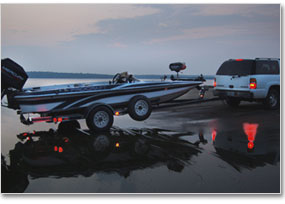 Some boaters just accept the fact that their trailer lights aren’t going to work. Others at least go through the motions of jiggling wires and thumping lens covers to try to get them to illuminate before accepting whatever the outcome and hitting the road anyway. But the bottom line is, trailer lights are required by law to work. Nobody likes getting a ticket for non-working trailer lights, but no one can question the logic behind the safety concerns of compliance. Trailers must be visible from all directions and stop/turn/tail lights must properly function. The good news is, replacing and keeping trailer lights working is easier now than it has ever been. Optronics understands the difficulty that do-it-yourselfers often have in determining the right replacement lights for their trailers, or even determining what trailer lighting is currently required by law in the first place. Therefore, we’ve provided charts and descriptions below to help with your selections. We’ve also assembled information pertinent to the light replacement process. Don’t let malfunctioning boat trailer lights discourage plans for an outing or be the reason for cutting a day trip short. Instead, become safe, legal and bright again by fixing, updating or upgrading trailer lights with one of the easy to install light replacement kits from Optronics. Basic Equipment Requirements |
||||||||||||
|
|
||||||||||||
| BASIC REPLACEMENT LIGHT INSTALLATION PROCESS | ||||||||||||
|
To replace existing trailer lights, find the appropriate Optronics trailer light model, incandescent or LED, to fit the current placement or cutout in the trailer’s frame. Tools and items needed
Things to know (general rules, but could vary if not a domestic vehicle or original equipment)
|
||||||||||||
Safety precautions before starting
A thoughtful approach
Get to work replacing those lights Okay, it’s time to get those lights replaced. Although the process won’t take long, be sure to start it when you have time and aren’t on a schedule. It’s not the kind of job you want to start when getting home at 5:30 p.m. on a Friday afternoon with intentions of rushing through it so you can go to the lake that night. However, it is a good project for just about any other weeknight. Here are a few steps to follow in their simplest from. Repeat the same process for each light being replaced.
Most Common Troubleshooting Fixes
|
||||||||||||
 |
| All LED trailer lights are not created equal. A partial single row of LEDs is all that remains working on this boat trailer’s "waterproof" right tail light after replacement only 15 months ago. Optronics LEDs are potted to seal out water. Notice the reflector replaced at the same time is also missing. |
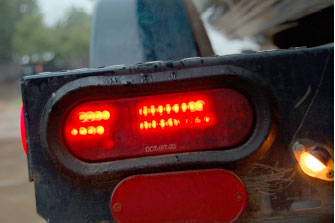 |
| More blinkety-blink LEDs. The left tail light on the same boat trailer hasn’t fared much better than the right. Although it has two rows of LEDs working, neither is a full row. The owner is faced with having to already replace tail lights again in less than two years. |
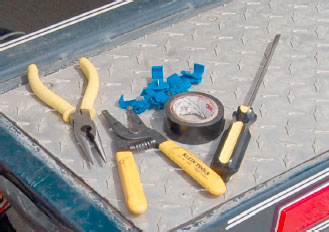 |
| Only basic tools needed. A pair of needlenose pliers, wire cutter/stripper, wire connectors or nuts, screwdriver and electrical tape are all you need to install most Optronics replacement light kits. |
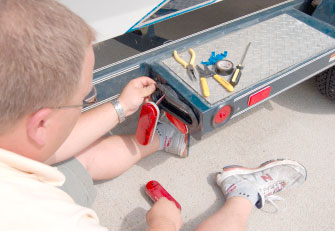 |
| Oval grommet tail lights a snap to replace. Any adept handyman or woman can install a replacement Optronics trailer light without problem. Each replacement kit comes with the sealed light insert, rubber grommet and pigtail. |
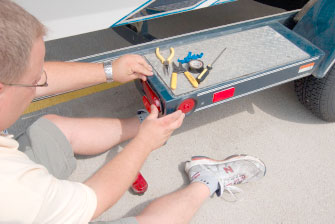 |
| That’s all there is to it. Connect the pigtail to the trailer’s wire using wire connectors or wire nuts. Plug the pigtail into the back of the LED cartridge. Fit the cartridge into the rubber grommet. Done! |
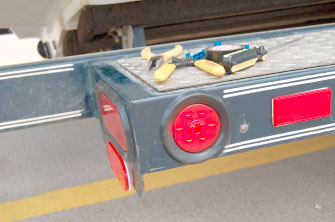 |
| A new, shiny hiney. With the tail light, side clearance light, and rear and side reflectors in place, the old trailer has a new beaming rear end. |
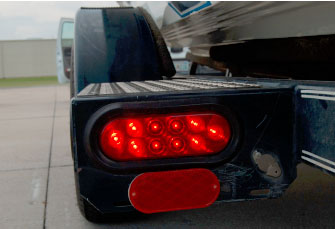 |
| Bold and the beautiful. The new Optronics LED tail light shines brightly, even in daylight, where once before the not-so-old brand X replacement light looked like a bad jack-o-lantern grin. |
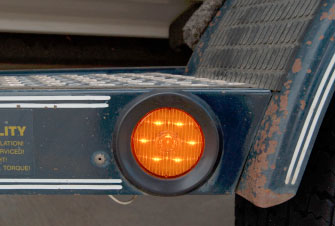 |
| New lights spruce up old trailer. Even with time and road wear rust spots, new trailer lighting makes an old trailer look good. More importantly, it makes an old trailer road-legal and safe for everyone on the highways. |
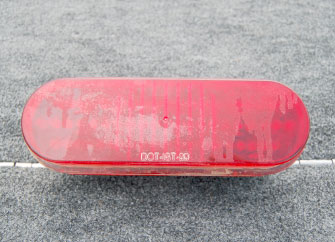 |
| It said it was waterproof. The brand X LED light said waterproof trailer light on the packaging. But after removal and closer examination, it’s easy to see part of the reason for failure was serious amounts of water had gotten on the inside. |
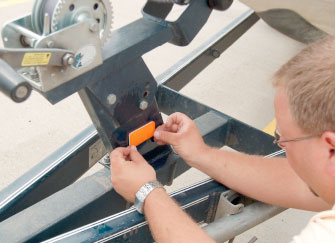 |
| Won’t pass as Rudolph. But the amber reflector on the trailer’s bow stop area serves to illuminate an otherwise dark area of the trailer when hit by headlights, whether passing through an intersection or sitting idle in a boat ramp parking lot. |

HOME | ABOUT US | CONTACT US
NEW PRODUCTS | Panelite Millennium Series | Truck & Trailer | RV Interior | Fog/Driving | 12-Volt Accessories
Optronics Spotlights | Hands-free Headlamps | Fish-N-Lites | Docking Lights
Replacing Boat Trailer Lighting
ph: 800-364-5483 fx: 918-683-9517



